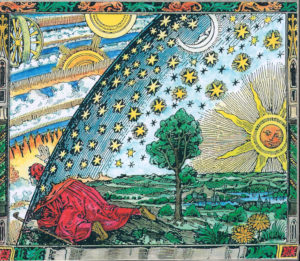
Embodied Alchemy®
What makes alchemy so valuable for psychotherapy is that its images concretize the experiences of transformation that one undergoes in psychotherapy […] Alchemy provides a kind of anatomy of individuation. ~ Edward Edinger

How do we evoke the light in the dark body? How do we embody the soul spark, bring it to consciousness, and live it more fully in our daily lives?
In today’s Western world, many traditionally verbal, cognitive therapeutic approaches prioritize mental insight over embodied experience and the spiritual dimensions of the healing process. Yet genuine healing involves more than verbalization: true insight needs to be experienced in the body and responded to within a conscious, empathic relationship in order to become integrated within the individual and brought into the community.
Modern psychotherapy is similar to alchemy in that it has the capacity to transform the unwanted, uncomfortable material of everyday life into something meaningful, thus helping us find the ‘gold’ in the shadow. Alchemy, the forerunner of modern chemistry, was practiced by mystics who sought to make gold from base elements.
Psychotherapy takes unconscious matter and brings it into the light, supporting healing and development at deeper levels of complexity and wholeness. Familiarizing ourselves with alchemy’s basic elements can illuminate our understanding of embodied transformative processes (experienced spontaneously through the practice of Authentic Movement, a therapeutic and body/mind meditative practice with roots in C. G. Jung’s active imagination approach). Both practices bring awareness to what we least value: base matter, known as prima materia by the alchemists and as unconscious, ‘shadow,’ qualities by Jung.
In fact, some analysts equate the body—with its implicit processes, unmetabolized affects and unknown interior landscapes—with the unconscious. Providing a timeless ‘map’ of the stages in the transformative/individuation process, alchemical practice uses the ‘dross’ of unwanted material to generate new life.
Such a map can help orient people in their therapeutic work, particularly when they are immersed in unconscious material that may provoke feelings of anxiety, impatience or dissolution. Without understanding these as natural parts of the healing process, the individual may abandon his or her efforts.
Jung’s work was the first to indicate the ways in which alchemy can be relevant to contemporary therapeutic practice: as a means of accessing the unconscious; as a model for the further development of consciousness/individuation; as a process of healing and transformation, accessing the vital essence or animating spirit in matter; and as a way of contextualizing the transformational process within the myths and cultural traditions across cultures.
Perhaps most importantly, alchemy’s emphasis on the harmonious marriage of opposites makes it a useful lens through which to view the contemporary problems of the mind/body/spirit split. Healing the split between body and spirit is a transformative process that goes beyond conscious control and social and cultural ideology: genuine healing requires access to and acknowledgment of compensatory material in the unconscious.
In contemporary Western culture, however, the means of access to embodied experience is limited. Untethered from the senses and emotions, spiritual practice can leave practitioners vulnerable to dogma or fundamentalist one-sidedness. On the other hand, on the somatic end of the spectrum, bodily practices that overemphasize the concrete, material dimension, with little awareness of spiritual aspects, run the risk of becoming too mechanical.
As fads catch on, even yoga—one of the oldest continuous spiritual practices created to develop mind/body/spirit unity—may be reduced to a method for sculpting perfect abs. When either spiritual or bodily perspectives become too one-sided, opportunities are missed for accessing what is emerging from the unconscious, integrating body, brain, psyche and spirit.
Embodied consciousness is essential not only to self-development and the evolution of therapeutic practice, but to the health and well-being of our world. In the body lies the gold, suspended in a dark matrix, waiting to be witnessed and cherished; only then can its fragments coalesce into a vibrant wholeness.
* Excerpts from: Stromsted, T. (2014). The alchemy of Authentic Movement: Awakening spirit in the body. In Williamson, A., Whately, S., Batson, G., & Weber R. (Eds.), Dance, somatics and spiritualities: Contemporary sacred narratives, leading edge voices in the field: sensory experiences of the divine (pp. 35-60). Bristol, United Kingdom: Intellect Books.
